The dwarf gourami (Trichogaster lalius) is a captivating small fish belonging to the Osphronemidae family, known for its striking colors and peaceful demeanor. However, despite its charm, this species requires careful attention and specific care compared to other Anabantoidei.
Dwarf gourami thrive in a well-maintained aquarium with stable water conditions. They prefer a tank environment that mimics their natural habitat, featuring densely planted areas and floating vegetation. This not only provides them with hiding spots but also helps reduce stress.
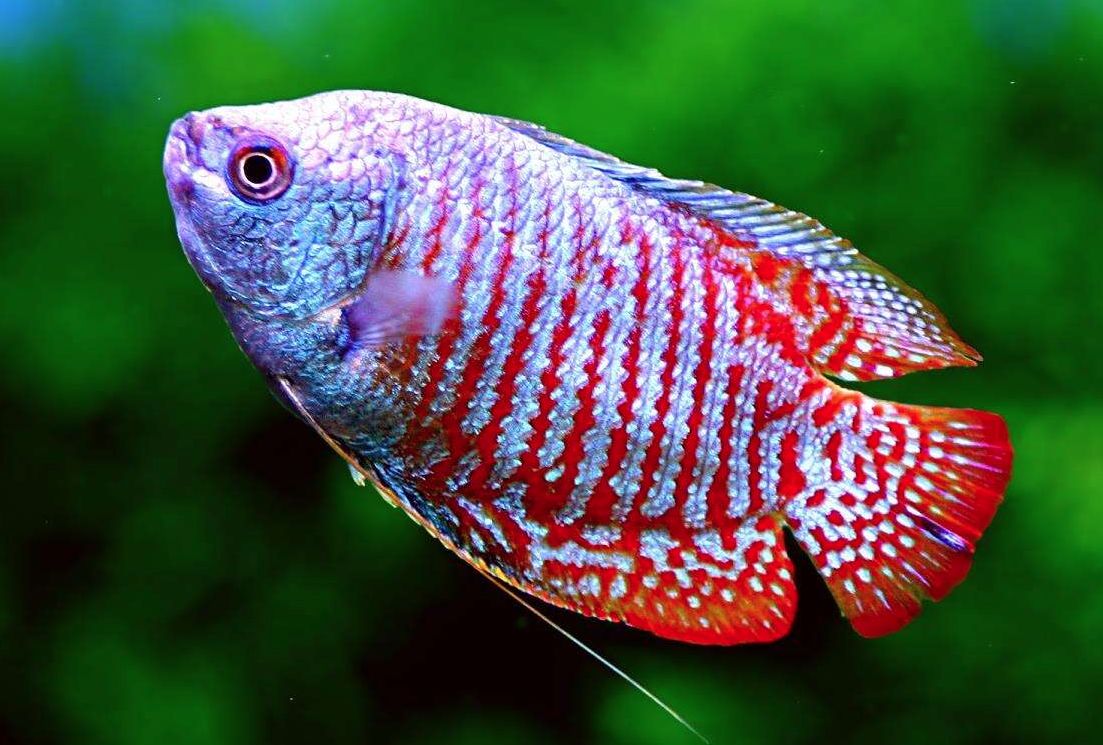
Contents
Habitat in the wild
Dwarf gouramis (Trichogaster lalius) are small, colorful freshwater fish belonging to the Osphronemidae family. Known for their vibrant hues and peaceful demeanor, these fish require careful attention to thrive, making them a rewarding choice for both novice and experienced aquarists.
Dwarf gouramis are native to regions of Pakistan, northern India, and Bangladesh. While earlier reports suggested their presence in Nepal and Malaysia, these claims are now considered likely misidentifications. Wild populations can also be found in Singapore, the USA, and Colombia.
In their natural habitat, dwarf gouramis inhabit slow-moving, densely vegetated waters such as ponds, bogs, ditches, streams, and irrigation channels. Their environments are rich in aquatic plants, including floating varieties like water lettuce and water hyacinth, as well as submerged species like vallisneria and hygrophila. These plants not only provide shelter but also serve as breeding sites and food sources.
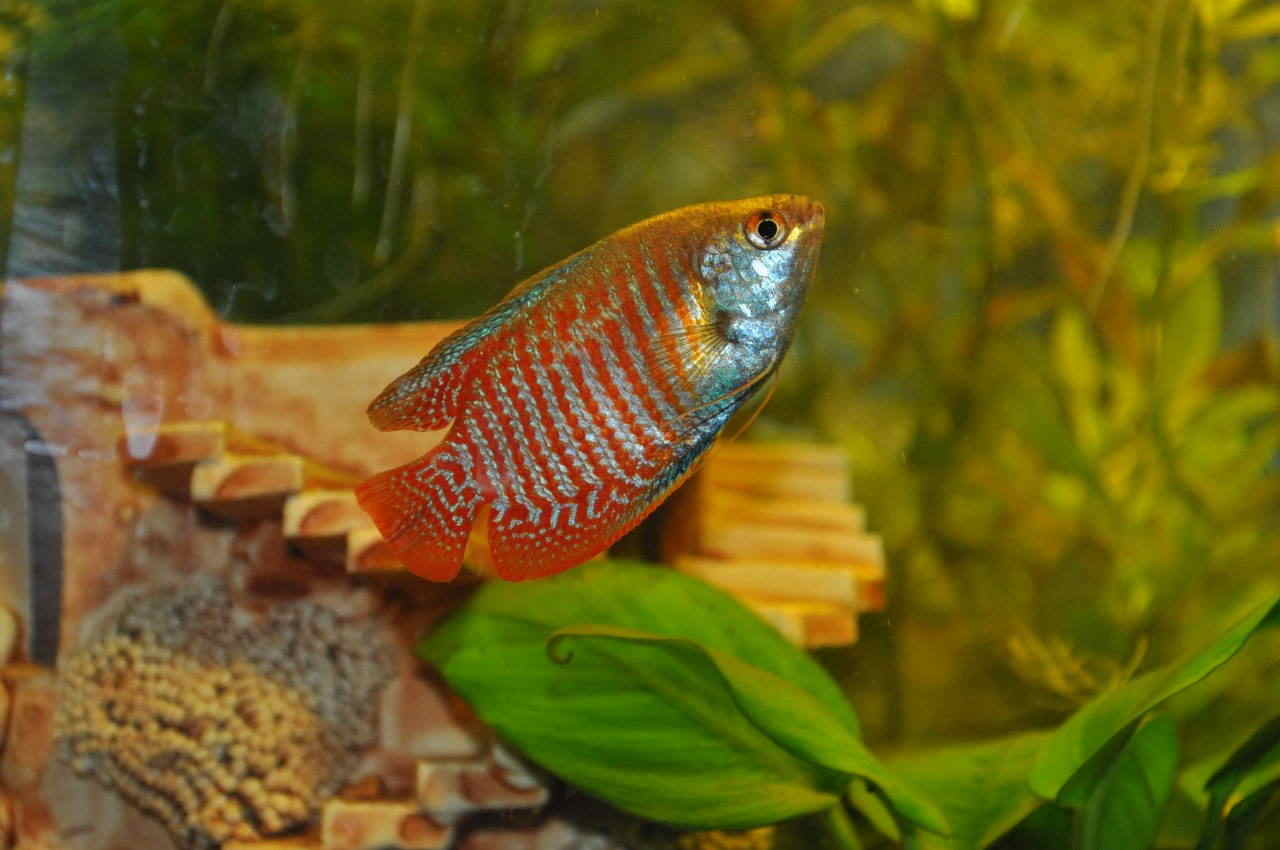
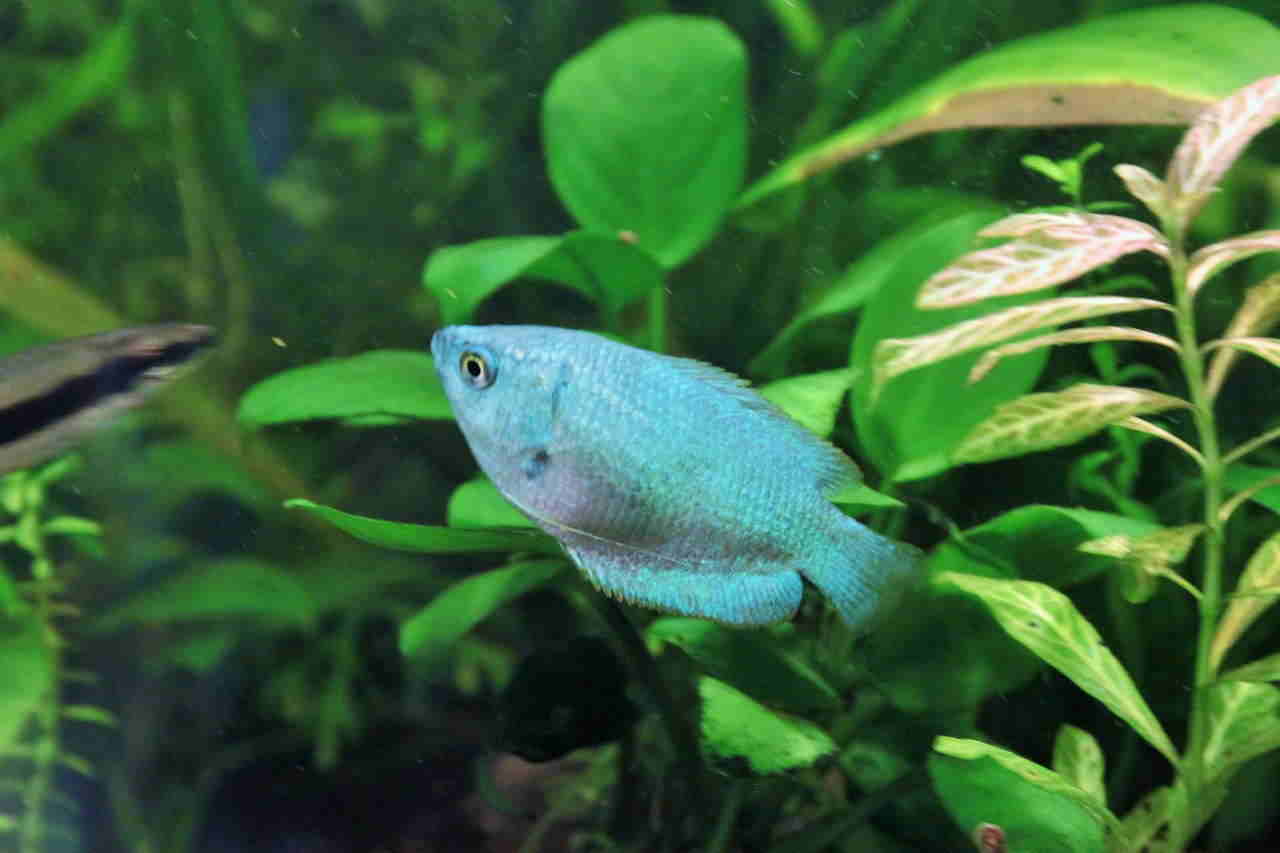
Description
Lifespan of Dwarf Gouramis
Dwarf gouramis (Trichogaster lalius) typically live for about 3 to 5 years in captivity. However, with optimal care and a suitable environment, some individuals can reach 6 years or even longer. Key factors contributing to their longevity include a balanced diet, well-maintained water conditions, and a stress-free habitat. Keep in mind that individual lifespans can vary based on genetics, overall health, and environmental factors.
Size of Dwarf Gouramis
Dwarf gouramis are relatively small fish, which adds to their popularity in the aquarium hobby. Males can grow up to 7.5 centimeters (3.0 inches), while females tend to be smaller, averaging around 6 centimeters (2.25 inches) in length.
Growth Rate of Dwarf Gouramis
Dwarf gouramis have a slow growth rate compared to some other fish species. They experience the most rapid growth during their early stages of life. In the first few months, they can grow from small fry to about 1 inch (2.5 centimeters) long. Under optimal conditions, including proper nutrition and care, they can reach their adult size of 5 to 7.5 centimeters (2 to 3 inches) within the first year or two. However, individual growth rates may vary, and some may take longer to reach their full size.
Physical Characteristics
Dwarf gouramis have a tall, oval-shaped body that is flattened from the sides. The dorsal and anal fins have long bases, and males are generally larger and more vibrantly colored than females. Notably, the pelvic fin rays are positioned in front of the pectoral fins. The body is adorned with horizontal red and sea-green stripes, which are also visible on their fins. Additionally, the dorsal, anal, and caudal fins feature striking red edges
Dwarf gourami types
Dwarf gouramis (Trichogaster lalius) come in several stunning color variants, or “types,” that have been selectively bred over time to highlight specific colors and patterns. These vibrant variations not only enhance the visual appeal of aquariums but also allow hobbyists to choose fish that best fit their aesthetic preferences.
Common Types of Dwarf Gouramis:
- Flame Dwarf Gourami: This variant showcases a vibrant red-orange coloration that resembles flames, adorned with vertical dark stripes that enhance its striking appearance.
- Powder Blue Dwarf Gourami: Featuring a soft light blue body, this type is accented by horizontal dark blue stripes, creating a calm and elegant look.
- Neon Blue Dwarf Gourami: Known for its bright, iridescent blue coloration, this variant stands out beautifully under aquarium lighting, adding a lively element to any tank.
- Red Dwarf Gourami: This type is characterized by its deep red coloration that envelops the body, making it a bold choice for aquarists seeking vibrant hues.
While these are just a few examples, the availability of color variants can vary depending on breeders and local markets. It’s essential to consider that each variant, while visually stunning, may have similar care requirements, including water conditions and diet.
| Characteristic | Description |
|---|---|
| Scientific Name | Trichogaster lalius |
| Size | Typically reach about 2-3 inches (5-7.5 cm) in length |
| Lifespan | Average lifespan is around 3-5 years, but can live longer with proper care |
| Coloration | Males have vibrant colors with iridescent patterns, while females are more subdued in color |
| Body Shape | Elongated body with a laterally compressed shape |
| Labyrinth Organ | Possess a specialized organ called the labyrinth organ, enabling them to breathe air |
| Behavior | Generally peaceful, but males can be territorial and may exhibit aggression during breeding |
| Compatibility | Can be kept with other peaceful community fish, but avoid fin-nipping tank mates |
| Water Parameters | Temperature: 77-82°F (25-28°C), pH: 6.0-7.5, Water hardness: 5-15 dGH |
| Feeding | Omnivorous diet consisting of high-quality dry flakes or pellets, supplemented with live/frozen foods |
| Habitat | Slow-moving streams, ponds, and rice paddies in South Asia |
| Reproduction | Bubble nest builders, males create bubble nests for egg fertilization and parental care |
| Common Varieties | Flame Dwarf Gourami, Powder Blue Dwarf Gourami, Neon Blue Dwarf Gourami, etc. |
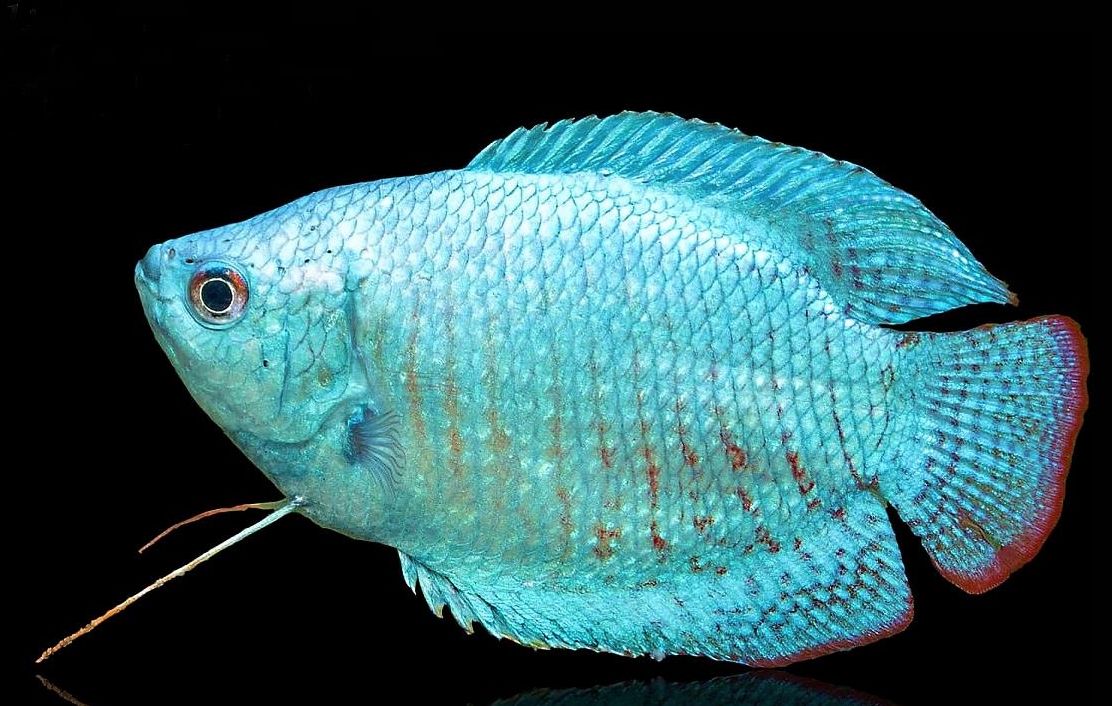
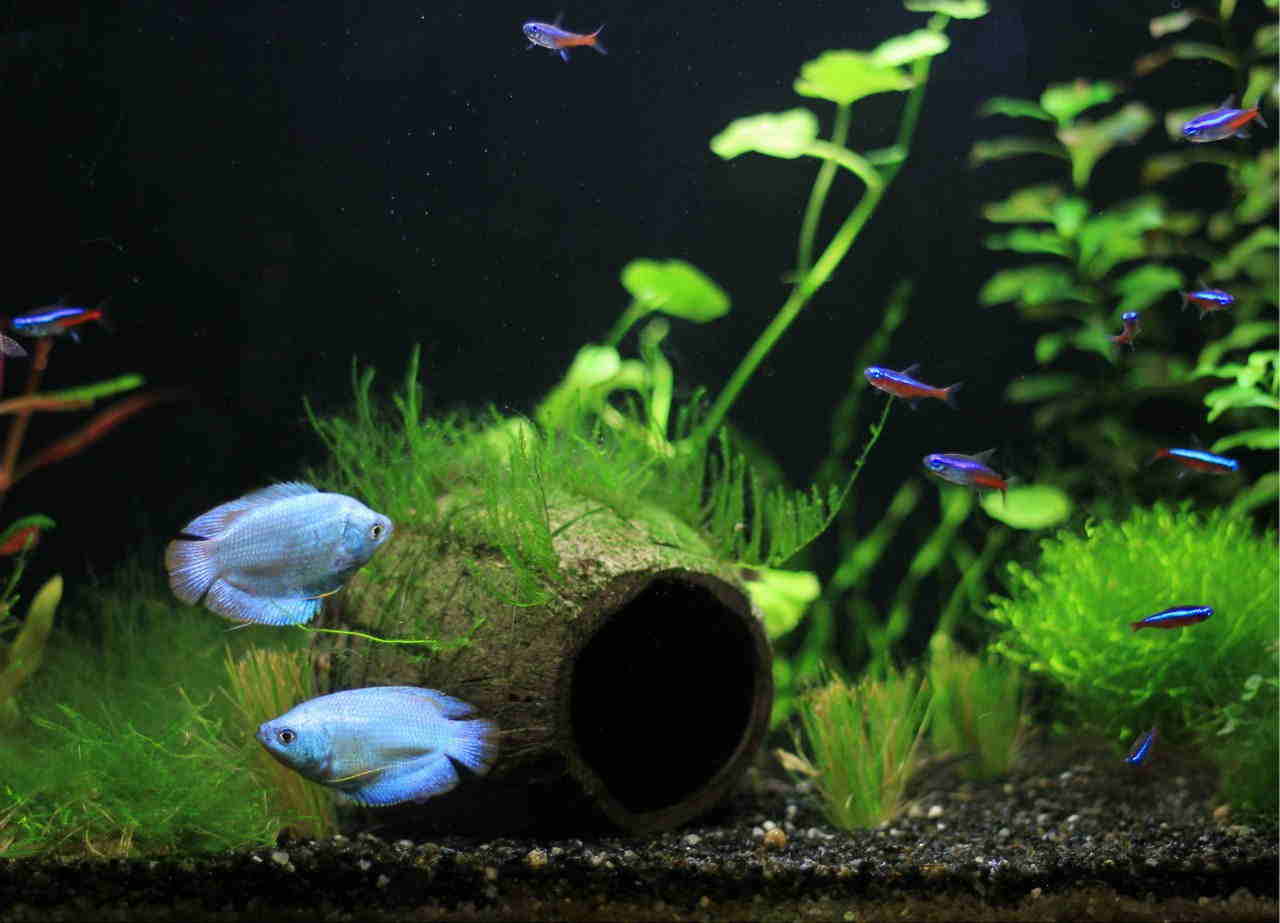
Care and keeping in a tank
Tank size
Dwarf gouramis can thrive in aquariums as small as 10 gallons (38 liters), but providing a larger tank is generally recommended for optimal space and swimming area. The appropriate tank size depends on several factors, including the number of dwarf gouramis and the presence of other tank mates.
Guidelines for Tank Sizes:
- Single Dwarf Gourami: For a solo dwarf gourami, a minimum tank size of 10 gallons is suitable. However, a 15-20 gallon (57-76 liters) tank is preferred, offering more swimming space and a better environment.
- Multiple Dwarf Gouramis: If you plan to keep several dwarf gouramis, consider their territorial nature. Keeping multiple males can lead to aggression and disputes. In this case, a larger tank—ideally a 20-gallon (76-liter) long tank—will allow for adequate space and help establish individual territories. It’s generally advisable to keep only one male in a community setting to minimize conflict.
- Community Tank: For a community aquarium with other peaceful species, a larger tank is essential to accommodate both the gouramis and their companions. A 20-gallon (76-liter) long tank or larger is recommended to provide sufficient space and reduce potential aggression.
Water parameters
Here are the preferred conditions:
- Temperature: 22 – 27°C (72 – 81°F)
- pH: 6.5 – 7.5
- Water Hardness: 2 – 18°H
Regular maintenance is key to a healthy aquarium. Perform partial water changes of 20-30% every one to two weeks. This practice helps maintain water quality and removes accumulated toxins, ensuring a safe environment for your fish.
Tank decor
Creating a suitable and comfortable environment for your dwarf gouramis is essential to their well-being. These fish are naturally timid and thrive in calm, well-structured habitats that mimic their native waters.
- Substrate and Water Flow:
- Just like other Anabantoidei, dwarf gouramis prefer a tank with minimal water flow. A strong current can stress them, as they are not strong swimmers. Choose a fine-grained substrate like sand or smooth gravel, which closely resembles their natural environment and allows them to forage for food.
- Lighting and Tank Decorations:
- Keep the lighting moderate with a natural spectrum to enhance plant growth and showcase the vibrant colors of your gouramis. Avoid overly bright light, as these fish appreciate subdued lighting. Adding floating plants, such as duckweed or hornwort, helps darken the tank and create a more calming space.
- To further simulate their natural habitat, incorporate decorations like snags, small tree branches, and leaves. These elements, combined with caves, driftwood, and dense vegetation, provide hiding spots and reduce stress, especially important for female gouramis who might be chased by males.
- Live Plants:
- Including live plants in the tank serves both aesthetic and functional purposes. Java moss, Anubias, and Amazon sword are excellent choices, offering cover and helping to maintain water quality by absorbing nitrates. Plants not only provide natural hiding spots but also contribute to a balanced and healthy ecosystem for your dwarf gouramis.
By offering a well-planned habitat with plenty of cover and subdued lighting, your dwarf gouramis will feel secure, reducing stress and promoting natural behavior.
Diet
In the wild, Trichogaster lalius are omnivorous, feeding on a variety of small insects, insect larvae, crustaceans, algae, and plant matter. Their diverse natural diet helps them thrive, and it’s important to replicate this variety in captivity to maintain their health.
- Staple Diet:
- In your aquarium, dwarf gouramis will readily accept a variety of foods. A balanced diet should include high-quality dry flakes or pellets specifically formulated for tropical fish. Look for products that contain a good mix of proteins, vitamins, and minerals to meet their nutritional needs. These commercial foods provide a solid foundation for their diet.
- Supplementing with Live and Frozen Foods:
- To ensure variety and keep your dwarf gouramis healthy, you should occasionally offer small live or frozen foods such as brine shrimp, daphnia, or mosquito larvae. These foods mimic their natural prey and provide enrichment, encouraging their natural hunting behavior.
- However, be cautious with certain foods like bloodworms. While many aquarists use bloodworms as a treat, some breeders believe they can cause digestive issues in dwarf gouramis. It’s a good idea to feed bloodworms sparingly or avoid them altogether if you’re concerned about their gastrointestinal health.
- Feeding Frequency and Portion Control:
- Dwarf gouramis are prone to gluttony and obesity, so it’s important not to overfeed them. Feed small portions 1-2 times per day and ensure that any uneaten food is removed from the tank to prevent water contamination. A “hunger day” once a week, where you withhold food, can also help prevent overeating and promote a healthy metabolism.
By offering a varied diet with occasional treats and practicing portion control, you can ensure your dwarf gouramis remain healthy and active, with vibrant colors and natural behavior.
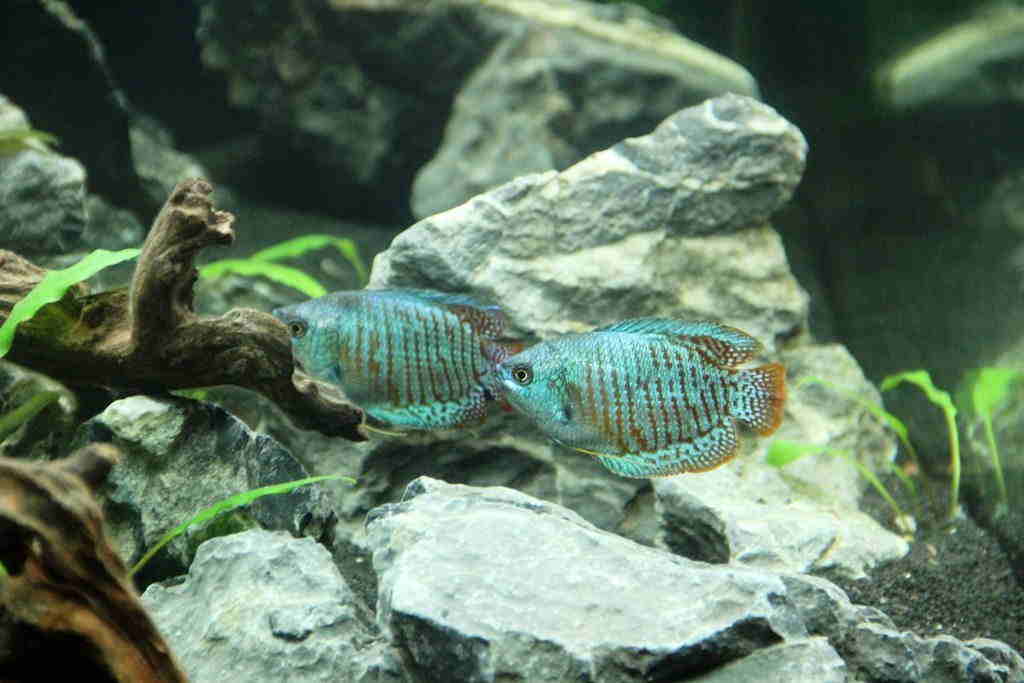
Tank mates
Dwarf gouramis can be compatible with various peaceful community fish species. When selecting tank mates for dwarf gouramis, it’s important to consider their relatively small size, peaceful nature, and specific tank requirements. Here are some suitable tank mates for dwarf gouramis:
- Harlequin Rasboras (Trigonostigma heteromorpha)
- Neon Tetras (Paracheirodon innesi)
- Ember Tetras (Hyphessobrycon amandae)
- Glowlight Tetras (Hemigrammus erythrozonus)
- Black Neon Tetras (Hyphessobrycon herbertaxelrodi)
- Cardinal Tetras (Paracheirodon axelrodi)
- Rummy Nose Tetras (Hemigrammus rhodostomus)
- Sparkling Gouramis (Trichopsis pumila)
- Celestial Pearl Danios (Danio margaritatus)
- White Cloud Mountain Minnows (Tanichthys albonubes)
- Dwarf Rasboras (Boraras spp.)
- Endler’s Livebearers (Poecilia wingei)
- Guppies (Poecilia reticulata)
- Platies (Xiphophorus spp.)
- Corydoras Catfish (Corydoras spp. – pygmy cory, panda cory, adolfoi catfish)
- Otocinclus Catfish (Otocinclus spp.)
- Bristlenose Plecos (Ancistrus spp.)
Are dwarf gouramis aggressive?
Dwarf gouramis (Trichogaster lalius) are not typically considered schooling fish. In the wild, they tend to be solitary or form small social groups rather than large, coordinated schools. This behavior translates to the aquarium, where they are often peaceful but can become territorial under certain conditions.
- Territorial Nature:
- While dwarf gouramis are generally peaceful, they can display territorial behavior, especially males. Male dwarf gouramis are known to become aggressive during breeding or when housed with other males. This can lead to chasing, fin-nipping, and even fighting. For this reason, it’s best to keep only one male dwarf gourami per tank to avoid conflicts.
- Although less common, female dwarf gouramis can also show territorial tendencies, particularly when guarding their fry or feeling threatened. Providing adequate space and plenty of hiding spots, such as plants, caves, and driftwood, helps diffuse potential aggression.
- Community Tanks and Tank Mates:
- Dwarf gouramis can be kept in community tanks, but they should be housed with peaceful, non-aggressive species to prevent stress. They are often good tank mates for fish like neon tetras, harlequin rasboras, and corydoras catfish. However, because of their timid nature, it’s important to avoid housing them with aggressive species or larger fish that may intimidate them.
- Managing Multiple Gouramis:
- If you plan to keep multiple dwarf gouramis, a larger tank is essential to prevent territorial disputes. It’s generally recommended to maintain a higher ratio of females to males to reduce male aggression. For example, in a 20-gallon tank, you could house one male and two or more females. This setup allows males to establish their territory without overwhelming the females.
By understanding their territorial behavior and providing appropriate tank conditions, you can ensure a peaceful and healthy environment for dwarf gouramis and their tank mates.
Gender differences: male vs female
Dwarf gouramis show clear sexual dimorphism, which means males and females can be distinguished by their physical appearance and behavior. Here are the main characteristics that set them apart:
- Size and Shape:
- Males are typically larger, growing up to 7.5 cm (3 inches) and have a more streamlined, slender body shape.
- Females are slightly smaller, usually around 6 cm (2.5 inches), with a fuller, rounder body, especially when carrying eggs.
- Coloration:
- Males display more vibrant, iridescent blue and red vertical stripes across their bodies, which become even more intense during breeding.
- Females, by contrast, have more muted colors, often silvery or pale, lacking the bold hues of the males.
- Fins:
- Males have elongated, flowing fins, particularly the dorsal and anal fins, which may appear more extended or pointed.
- Females have shorter, more rounded fins that are less dramatic in appearance.
- Behavior:
- Males tend to be more territorial, especially during breeding periods, often showing aggressive behavior like flaring, chasing, and fin displays to assert dominance.
- Females are generally more peaceful and less prone to territorial behavior.
- Bubble Nest Building:
- Males build bubble nests at the water’s surface during breeding, where they guard the fertilized eggs until the fry hatch.
- Females focus on laying eggs, usually in or near the male’s nest, but do not participate in building the nest.
While these traits are reliable in identifying adult dwarf gouramis, juvenile fish may not exhibit clear differences until they mature. Behavioral differences, especially territoriality and bubble nest building, become most noticeable during the breeding season.
Breeding
Becomes reproductive when being 4-5 cm long. As many other Anabantoidei fish, dwarf gourami are bubble nest builders. Breeding is quite an easy process and only spontaneous behavior of the male may give some trouble.
A tank of 2-4 gallons capacity can be used as a spawning tank. The water level should be about 10 cm high, since dwarf gourami juveniles are born without completely developed labyrinth organ and they require some easily accessible oxygen.
The water should be soft, about 4 -6°dH. You don’t have to put any substrate on the spawning tank bottom, however to soften the water you may put about 2 pieces of turf in the tank. The tank should have a lid on top, since the juveniles need some warm humid air to breathe. Some breeders put polythene film on top of the tank for this purpose.
If not provided with required hothouse conditions, the development of the labyrinth organ may take significantly longer.
In the tank corners there should be lots of plants, so dwarf gourami female has some place to hide from the aggressive male during the spawning period. Put some Riccia on the water surface, since it is actively used by the male to build its nest of bubbles.
Couple should be separated before they are put into a spawning tank to get completely ready for spawning. Their diet should include a variety of live and frozen feed. When the dwarf gourami female becomes rounded with the eggs inside it, it’s put into the spawning tank and during the next week it’s getting used for the new environment.
If everything goes fine, the dwarf gourami male starts building a nest – it creates some construction of bubbles on the water surface, using some plants to strengthen the construction.
During this period of time male starts to attack the female and therefore there should definitely be some covers and plants in the tank.
Once the nest is built, the dwarf gourami change their behavior. The male stops being aggressive to the female one, and the latter becomes a dominant fish. The female swims under the nest and touches the male with its face. The spawning occurs under the nest with the “embraces” typical for Anabantoidei fish.
The male embraces the female one with its body and the eggs and sperm are output simultaneously. Then the couple goes apart and the female gets down on the tank bottom. The fertilized eggs have positive buoyancy and they go up to the bubble nest.
The dwarf gourami male then gathers those eggs that are scattered around the tank. The female lays the eggs several times. After the spawning is over male starts haunting and beating the female and it can even kill her. That’s why you should remove her from the tank once the spawning is over.
Male himself takes care after the nest. He adds some air bubbles, removes spoilt eggs, and guards the nest. The incubation period is about 48 hours.
About 3-4 days later the juveniles will start to swim. Now you can remove the male from the spawning tank and start feeding juveniles with infusorians and crustaceans nauplii or at least with some egg yolk.
The juveniles grow comparatively slow and they have different rate of growth, so it’s necessary to sort them from time to time. With the time you may start feeding them with more large sized feed. When the juveniles become about 1.5-2 month old the stripes specific to adult fish appear on the body.